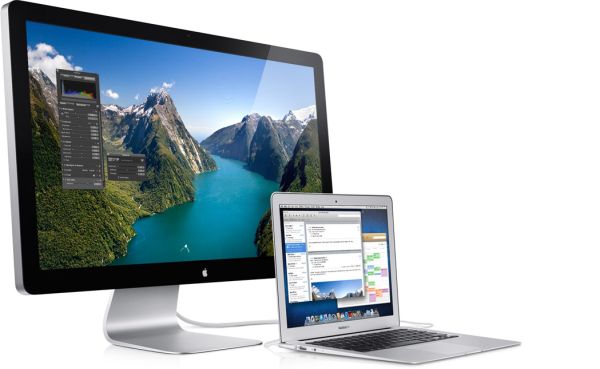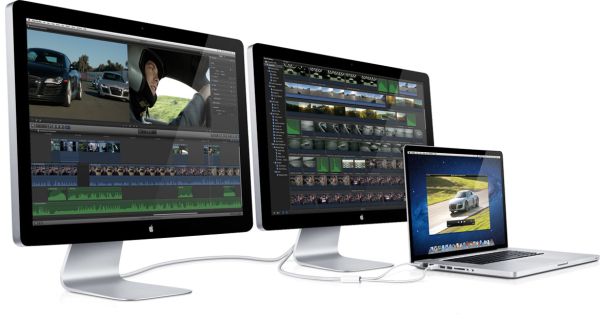Apple Updates Cinema Display, It's a Thunderbolt Display Now
by Kristian Vättö on July 20, 2011 12:25 PM EST- Posted in
- Apple
- Mac
- Cinema Display
- Thunderbolt
- Thunderbolt Display
Along with today’s MacBook Air and Mac mini updates, Apple has also updated their 27” Cinema Display. The display now goes by a new name: the Apple Thunderbolt Display (ATD). As the name implies, the display now features Intel’s new Thunderbolt interface, which Apple has heavily adopted in all new 2011 Macs. The ATD is world’s first commercially available Thunderbolt display and the second Thunderbolt device, the first one being Promise’s Pegasus enclosure.

Lets go through the specifications now:
| Apple Thunderbolt Display Specifications | |
| Screen size | 27" |
| Resolution | 2560x1440 |
| Panel type | In-plane switching (IPS) |
| Brightness | 375 cd/m2 |
| Viewing angles | 178°/178° |
| Contrast ratio | 1000:1 |
| Response time | 12ms |
| Cables (built-in) | Thunderbolt, MagSafe |
| Ports | 3x USB 2.0, FireWire 800, Gigabit Ethernet, Thunderbolt |
| Video and audio | FaceTime HD camera with mic, 2.1 speaker system |
| Dimensions (WxDxH) | 25.7" x 8.15" x 19.35" |
| Weight | 23.5lb |
| Price | $999 |
Essentially, the ATD is just a 27” Cinema Display with Thunderbolt. The screen size is the same, the resolution is the same, and I wouldn’t be surprised if the panel was exactly the same as well. From outside, you can’t see any difference, sans the extra ports. The dimensions are a match. Even the price stays at $999.
The difference comes when we talk about Thunderbolt and what it brings. The Cinema Display had three cables: Mini DisplayPort, MagSafe (power) and USB 2.0. Thanks to Thunderbolt, mDP and USB 2.0 have been merged into one and there are now only two cables: MagSafe and Thunderbolt.
Laptop-as-a-desktop users rejoice, the Thunderbolt Display features FireWire 800, USB 2.0 and Gigabit Ethernet - all of which are carried over the single Thunderbolt cable. There is also a second Thunderbolt port for daisy-chaining. As Thunderbolt provides up to 10Gb/s per channel, it’s more than adequate for 2560x1440 display and an external RAID box as we mentioned in our Promise Pegasus R6 & Mac Thunderbolt Review.
Example of daisy-chaning
Apple's Thunderbolt Display really shows us the potential of Thunderbolt by integrating many different interface standards into a single cable. Honestly the only thing that's missing is audio-out on the Thunderbolt Display itself for users who prefer external speakers.
The biggest, and possibly the only, issue here is USB 2.0 - it feels so outdated considering that nearly all PCs have USB 3.0 now. We probably won't see USB 3.0 support from Apple until Ivy Bridge brings it natively in 2012. However, even with only USB 2.0, the ATD is a great option for the owners of 2011 Macs with Thunderbolt. Apple will continue to sell the existing 27-inch Cinema Display as the new Thunderbolt Display will not work with machines that don't support Thunderbolt.
The Apple Thunderbolt Display is available from Apple's Online Store with an estimated shipping time of 6-8 weeks.











82 Comments
View All Comments
AmdInside - Wednesday, July 20, 2011 - link
I still feel Thunderbolt is one of the least necessary technologies to come out recently. No backwards compatibility. Expensive cables. Dedicated chip. I'd prefer if Apple could support USB 3.0 now instead of later with Ivy Bridge. Oh and blu-ray.djgandy - Wednesday, July 20, 2011 - link
> Expensive cablesMost technologies are expensive in their infancy. Should we stop progressing because demand for new technology on release is not equal to the demand of older technology?
Once the demand for 1 Billion cables per year is there the cables will be 99c.
USB used to have dedicated chips too. You can't expect manufacturers to put your new, unproven product onto all their chip designs before they have even seen what it is capable of.
AmdInside - Wednesday, July 20, 2011 - link
Name me one connectivity technology that's been as expensive as Thunderbolt and offered so little benefit to average user?dagamer34 - Wednesday, July 20, 2011 - link
People seem to think that USB wasn't in the same position 14 years ago. It was. Expensive cables. No devices, No support. Any new technology emerges this way and it takes time to get to an "affordable" price point.AmdInside - Wednesday, July 20, 2011 - link
I worked in retail when USB came out. There were much more devices and pricing wasn't expensive.diamondsw2 - Wednesday, July 20, 2011 - link
Based on your forward-thinking nature, I'm betting you still do.The whole $50 cable thing will be a distant memory in a year. Or perhaps, working in retail, you don't recall what pre-1998 USB looked like. Ports on every motherboard - and almost no peripherals and no demand for *years*. And then the iMac hit.
Look real close at the Air - one of Apple's most popular laptops (enough so that they just dropped the white MacBook). Your connectivity options are single USB 2.0... and Thunderbolt. You're going to see an explosion of peripherals, if only catering to MacBook Air owners.
The MacBook Air market *alone* is far, far larger than the iMac market was in 1998. If the iMac could jumpstart USB, the Air can jumpstart Thunderbolt.
AmdInside - Wednesday, July 20, 2011 - link
Nope. Only worked in retail while in college. Hated it.Arguing now is like arguing about an NFL draft or NBA draft on draft day. I still believe Thunderbolt or derivative will not be big a year from now nor will prices come down that much. My personal gripe is just that there are other technologies that Macs are missing and would be more useful to me than Thunderbolt and wish Apple added or at least made BTO.
bigboxes - Thursday, July 21, 2011 - link
He's right though. USB3.0 should be green-lighted. I remember a proprietary bus that was expensive. I just had to have it. So, I went out and bought an expensive firewire pci card. Never used the thing. Every device I bought used the USB2.0 standard. Of course that has happened to me many times. Buying things that I didn't pan out. I had an iOmega zip drive (CD-R killed them). I had a SCSI CD burner (IDE drives improved enough to kill them). USB3.0 is better because it is backwards compatible.Now, I know that Thunderbolt is more capable, but do we really need it yet? I'm thinking that a future USB4.0 standard can address those demands when the need arises.
fingerbob69 - Thursday, July 21, 2011 - link
The reason this has only USB2.0 for the sake of current users. Future users will only get Thunderbolt because Apple will not adopt USB3.0.Thunderbolt is an Intel/Apple IP. Apple do not want any and all peripherals able to link to Apple gear only v.expensive Apple made or only slightly less? expensive Apple licensed equipment.
Thunderbolt is Apple's gatekeeper in this endeavour. iPad3 will have Thunderbolt only (if it has any connectivity at all).
knutjb - Thursday, July 21, 2011 - link
Quote "...as the new Thunderbolt Display will not work with machines that don't support Thunderbolt."Apple and Intel are doing more than just skipping USB 3, they are doing what PCs would be lambasted for, they are making their old systems incompatible with their new model lines.
As always with Apple keeping up with the Jones' is required to integrate. They don't want to be backwards compatible, not enough profit in it. So long as they keep their following they will continue to do so.
The tech is interesting but the marketing sucks.